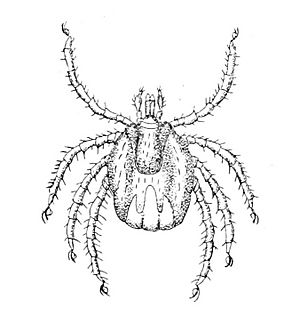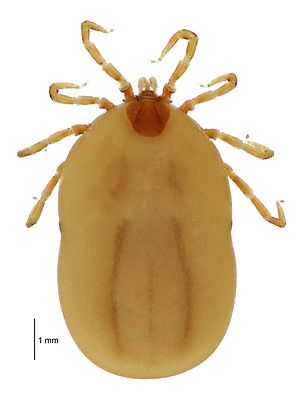Seabird tick facts for kids
Quick facts for kids Seabird tick |
|
|---|---|
 |
|
| Scientific classification |
The Ixodes uriae, often called the seabird tick, is a tiny parasitic tick. It lives on marine birds. You can find these ticks in many cold places around the world. This includes areas like Alaska, Canada, Iceland, Greenland, Norway, Russia, and even parts of Australia and South Africa.
Contents
How the Seabird Tick Grows: Its Life Cycle
Scientists have studied how these ticks grow. They looked at ticks living on king penguins and macaroni penguins.
On king penguins, the tick's life cycle took about three years. The ticks only fed for a few months each year. This was true even though the penguins were there all year. Most ticks spent the winter without feeding.
But on macaroni penguins, the cycle was shorter, only two years. This is because macaroni penguins spend different amounts of time at their breeding and molting sites.
Another study looked at ticks in an Adélie penguin colony. It found that ticks would feed and then gather under rocks. Ticks that had just fed found these gathering spots using a special chemical signal called a pheromone. A substance called Guanine, which ticks excrete, helped them gather.
Ticks that hadn't fed yet were attracted to penguin droppings (guano) and uric acid. These chemicals act like a "kairomone." This helps the ticks find their penguin hosts. After feeding, young ticks stopped responding to these signals for a few days. This happened until they had shed their skin and grown.
What Diseases Can Seabird Ticks Carry?
Ixodes uriae ticks can carry a type of bacteria called Borrelia garinii. This bacteria can cause Lyme disease in humans.
However, for humans to get Lyme disease from this bacteria, another tick species is usually needed. This is the Ixodes scapularis tick, which lives on deer. Seabirds and deer usually don't live in the same places. So, it's very rare for these ticks to pass the disease to humans. The risk to people from infected Ixodes uriae is very low.
Scientists have also found different viruses in Ixodes uriae ticks. For example, in 1975, the Nugget virus and Taggert virus were found in these ticks on Macquarie Island.
Later, in 2009, more viruses were found in ticks living with Macquarie Island penguins. These included the Gadgets Gully virus and Precarious Point virus. They also found new viruses like Sandy Bay virus, Catch-me-cave virus, and Finch Creek virus. This shows that these ticks can carry many different types of viruses.
Images for kids
See also
 In Spanish: Ixodes uriae para niños
In Spanish: Ixodes uriae para niños



